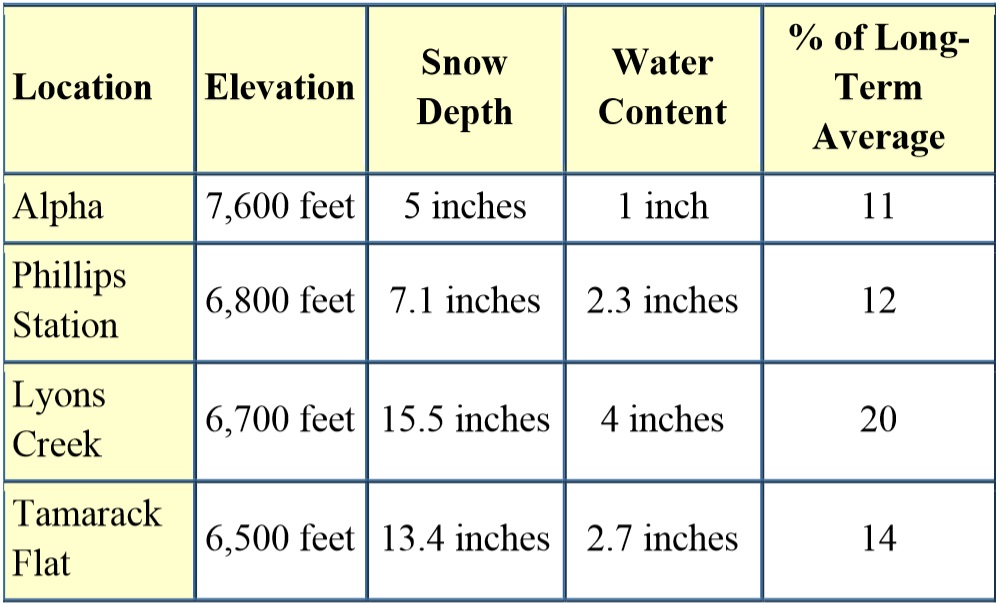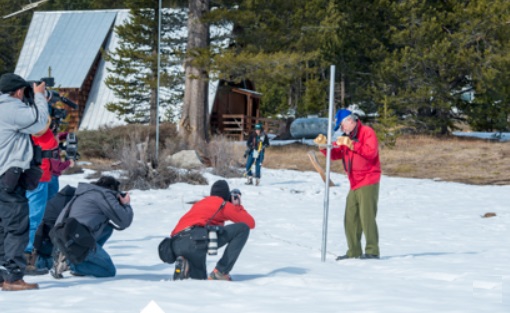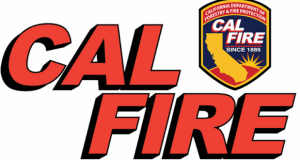SIERRA NEVADA – The absence of precipitation in January, normally California’s wettest month, has combined with warmer-than-average temperatures to produce a dismally meager snowpack for a drought-stricken state, says the Department of Water Resources (DWR).
Today’s second manual snow survey of the season found a snow water equivalent of just 2.3 inches in the scant snowpack near Echo summit approximately 90 miles east of Sacramento.
That is just 12 percent of the long-term average for this time of year at that particular snow course. Statewide, the snow water equivalent as measured by more than 100 sensors was 4 inches today, or 25 percent of the historical average. That’s down from Dec. 30, when DWR conducted the winter’s first manual survey; the statewide snow water equivalent was 50 percent of that date’s long-term average.
The Department of Water Resources has measured the winter snowpack’s water content for decades. In normal years, the snowpack supplies about 30 percent of California’s water needs as it melts in the spring and early summer. The greater the snowpack water content, the greater the likelihood California’s reservoirs will receive ample runoff to meet the state’s water demand in the summer and fall.
Unfortunately, today’s manual snow survey makes it likely that California’s drought will run through a fourth consecutive year. DWR managers said heavy precipitation and cooler temperatures in the next three months would be required for the snowpack to build and give Californians hope for beginning to recover from drought this year.
Results of today’s manual readings by DWR near Echo Summit off Highway 50 are as follows:

After December storms delivered above-normal precipitation in the northern Sierra, virtually no rain has fallen there in the past month, and even less has been recorded in Central California. The 8-station index in the northern mountains was at 146 percent of normal after those storms but now is only 88 percent of normal for today’s date. Just a few tenths of an inch of rain have fallen there since Christmas. The San Joaquin 5-station precipitation index is at 46 percent of normal.
The state’s major water supply reservoirs reflect that meager precipitation record. Lake Oroville in Butte County, the State Water Project’s (SWP) principal reservoir, now holds 41 percent of its 3.5 million acre-foot capacity (62 percent of its historical average for the date).
Shasta Lake north of Redding, California’s and the federal Central Valley Project’s (CVP) largest reservoir, is at 44 percent of its 4.5 million acre-foot capacity and 65 percent of its historical average.
San Luis Reservoir, a critical south-of-Delta pool for both the SWP and CVP, is faring better due to recent water deliveries to the reservoir as a component of the agencies’ drought management strategy. San Luis holds 53 percent of its 2 million acre-foot capacity (68 percent of normal for the date).
State Climatologist Michael Anderson has said that to have a chance at ending the drought, California would have to record precipitation that is at least 150 percent of normal by the end of the water year on September 30, or 75 inches as measured by the 8-station index. As of today, only 23.1 inches have been recorded at the stations.
Governor Edmund G. Brown Jr. declared a drought State of Emergency on January 17, 2014 and directed state officials to take all necessary actions to prepare for water shortages. He called on all Californians to voluntarily reduce their water usage by 20 percent. Conservation – the wise, sparing use of water
– remains California’s most reliable drought management tool. Each individual act of conservation–such as letting the lawn go brown or replacing a washer in a faucet to stop a leak – makes a difference over time.
Join other Californians at SaveOurWater.com to learn easy ways to save water every day, and visit drought.ca.gov to learn more about how California is dealing with the effects of the drought.
Electronic snowpack readings are available on the Internet at: http://cdec.water.ca.gov/snow/current/snow/index.html
Reservoir conditions are found here: http://cdec.water.ca.gov/cgi-progs/reservoirs/RES
For a broader snapshot of current and historical weather conditions, see DWR’s “Water Conditions” and “Drought” pages:
Water Conditions Page: http://www.water.ca.gov/waterconditions/waterconditions.cfm
Drought Page: http://www.water.ca.gov/waterconditions/index.cfm
Everyday water conservation tips may be found by clicking on Save Our Water at: http://www.saveourwater.com
Visit SaveOurWater.com to find out how everyone can do their part, and visit http://drought.ca.gov to learn more about how California is dealing with the effects of the drought.
The Department of Water Resources operates and maintains the State Water Project, provides dam safety and flood control and inspection services, assists local water districts in water management and water conservation planning, and plans for future statewide water needs.




